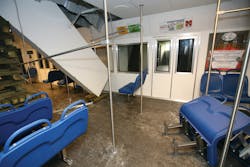CDP Offers New Subway Training Module
The Center for Domestic Preparedness (CDP) has a number of enhanced training venues to provide critical and relevant training in specialized emergency response to modern threats.
A mass-casualty incident on a bus, subway, streetcar or other modes of public transportation is one such threat. The confined space, limited visibility, concentrated victims, and unique supporting facilities associated with these transportation systems present responders with a very complex and challenging situation and environment. Add toxic chemicals, biologic agents, or explosives and that environment becomes a nightmare. The opportunity for responders to learn and practice the skills and techniques associated with these very unique threats and demanding situations can help ensure the safety of responders and the quick and effective response to recover victims.
The CDP established a subway, as part of its newest training venue. The subway features four full-size cars complete with lighting, smoke, seating, video capability, and even realistic commercial signage that is common in subways. One car is structurally damaged and contains debris and hazards associated with a tunnel collapse. Another car shows the blast and other damage from the detonation of an improvised explosive device.
"We created the subway system based on the actual size of passenger transportation systems found in the United States," said Chuck Medley, CDP branch chief for training management. "It provides us an opportunity to present hazards that responders may encounter when responding to a mass casualty incident associated with public transportation systems. In addition to the tunnel collapse and explosion, we can also simulate potential chemical and biological threats."
During training, emergency responders will have the opportunity to enter one car breached by falling concrete and threatened by simulated electrical hazards, and given the task of properly triaging survivors and transporting them to the appropriate medical personnel. They will also be required to find the source of any contamination that may be present and mitigate that threat so law enforcement, rescue, and emergency medical services can assist survivors.
"The CDP develops training based on potential threats, and the threat to our cities' public transportation systems is real. This venue, while simulating a subway, also replicates the complexity of response to other public transportation modes including busses, trains, and even street cars" said Medley. "This training will increase the edge for emergency responders to successfully respond."
Many cities in the United States operate public transportation systems like subways and their citizens are dependent on them being safe. The CDP's new subway provides a convincing scene that supports the realistic and complex training necessary to determine the appropriate actions and execute the safe and effective response by emergency responders.
The CDP is the Federal Emergency Management Agency's (FEMA) premier all-hazards training facility in Anniston, Ala. They have developed advanced training for emergency response providers, emergency managers, and other government officials. The training focuses on incident management, mass casualty response, and emergency response to a catastrophic natural or man-made disaster. They offer the only program in the nation featuring emergency response training exercises using chemical agents and biological materials. (Click here to read a recent article about enhanced hazardous materials training.)
The CDP also operates the only hospital facility in the United States dedicated solely to preparing the healthcare, public health, and environmental health communities for mass casualty events related to terrorism or natural disasters.
Training at the CDP campus is federally funded at no cost to state, local, and tribal emergency response professionals or their agency. For more information or to register for CDP specialized programs or courses, visit: http://cdp.dhs.gov.
SHANNON ARLEDGE is a public affairs specialist with the Center for Domestic Preparedness.
